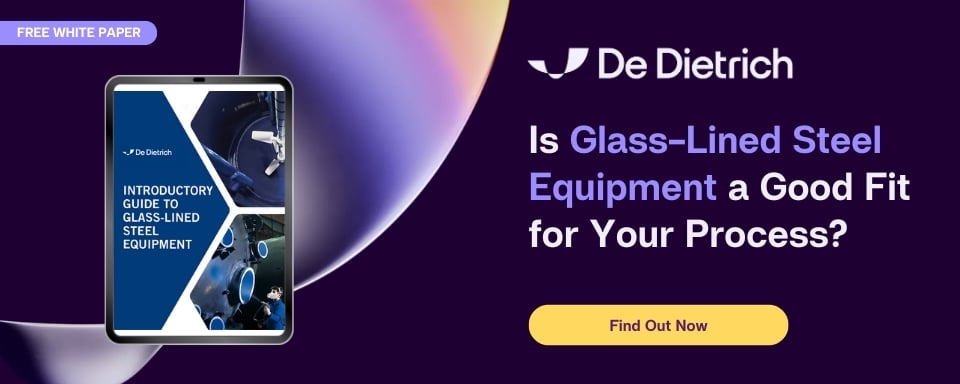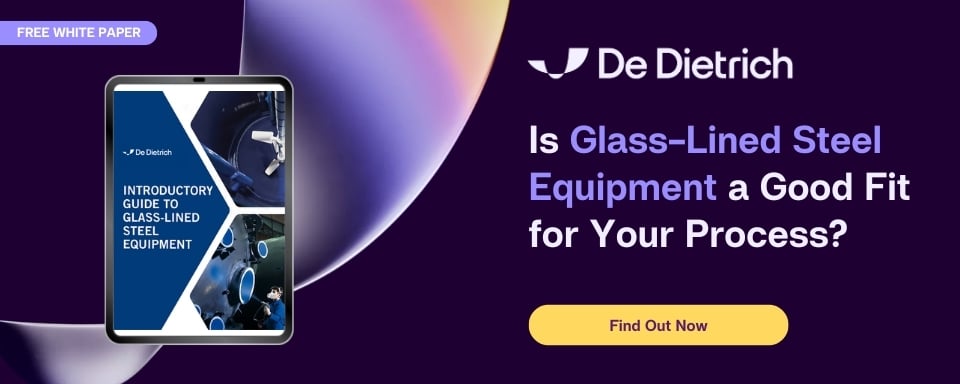(Your) Questions and (Our) Answers about Glass-Lined Equipment
 The main purpose of our Solutions Ahead blog is to write about topics that you, our readers, want to hear about. We are constantly brainstorming ideas for posts that we think are interesting, but what better way to come up with good subject matter than to get it directly from you?
The main purpose of our Solutions Ahead blog is to write about topics that you, our readers, want to hear about. We are constantly brainstorming ideas for posts that we think are interesting, but what better way to come up with good subject matter than to get it directly from you?
Over the past few months we’ve been compiling questions you come to us with. Surely if a few people are inquiring, there are dozens more who have the same question but just haven’t asked it. After reading this post, which contains questions and answers related to glass-lined equipment, you might have a few questions of your own so please reach out to us and ask! We are always happy to provide more information to give you a better understanding about the products we offer so you can make an informed decision when it comes to finding the right solution for your application.
Q: What are the advantages of using glass-lined equipment?
A: There are several advantages in the unique characteristics of glass lining that make this material of construction a top selection of design engineers. Here are some key reasons why glass-lined steel can benefit your process:
- Corrosion Resistance - Glass-lined steel provides superior corrosion resistance to acids, alkalis, water and other chemical solutions(with the exception for hydrofluoric acid and hot concentrated phosphoric acid). As a result of this chemical resistance, glass lining can serve for many years in environments that would quickly render most metal vessels unserviceable.
- Versatility - The chemical, mechanical, and thermal properties of glass are proof that this material can handle a diverse range of operating conditions. Users of glass-lined equipment are therefore able to make drastic changes to their process without needing new equipment to do so.
- Purity - Aggressive reaction environments and extractable metals can cause undesirable catalytic effects or fluctuations in process reactions leading to product contamination in unlined steel or alloy reactors. Glass-lined steel is inert so it is impervious to contamination. Additionally, it does not adversely affect flavor or color, which is of extreme importance to food and drug applications where purity is essential.
- Cleanability - Glass-lined steel has been adapted to cGMP requirements for cleaning, cleanliness, and sterilization. Its high degree of surface smoothness makes it easy to clean using non-corrosive, low pressure cleaning systems. The smooth surface of glass-lined steel also resists the buildup of viscous or sticky products, which means less frequent cleaning.
- Durability - The combination of glass and steel provides you with the best of both materials of construction; fusing glass to steel produces a composite material with an inside that offers product protection and an outside that provides structural strength and durability.
Q: Why are glass lining color options blue and white?
A: The blue coloring comes from the cobalt that was added to the glass formulations a long time ago. Usually the choice of which color to use comes down to concerns about cleaning and what particles could be left behind. If people are concerned with dark-colored particles being left on the surface, they will usually choose a white glass so they can see the particles either. If the particles are a lighter color, then you would choose a blue glass. Also, if you are going to be observing the reaction (using a vessel light) during operation, white glass tends to be a bit better in terms of being able to see what is going on inside.
Q: How are the level measurement marks made on agitators?
A: We create the lines/lettering using the contrasting glass color. So, blue lines on a white agitator or white lines on a blue agitator.
Q: What temperature range should glass-lined equipment be expected to serve?
A: The minimum temperature allowance for a standard glass-lined steel reactor is -20°F (-29°C). For cryogenic processes that require even lower temperatures there are special models that can be designed to accommodate temperatures as low as -76°F (-60°C). The maximum temperature is 500°F ( 260°C).
Another factor to take into account is temperature change limitations. This refers to the allowable temperature differential between the vessel walls and the product. Simply put, if you put something into a reactor and the temperature of the product varies too greatly from the temperature inside the reactor you can cause a lot of damage. For more information on preventing thermal shock read out post on how to protect your glass-lined equipment.
Q: What’s the difference between half-coil jacketing and conventional jackets?
A: The half-pipe or split-coil jacket (referred to by De Dietrich as HemiCoil®) consists of a welded half pipe that wraps around the outside of the vessel, creating a circular path for the heat transfer fluid to pass through. In a split-coil jacket, heating and cooling media flow through the pipe coils with high velocity and turbulence. Thus, film coefficients and heat transfer rates are higher than in conventional jackets. Vessel contents heat up and cool down, and the heat transfer circuit drains much faster-saving energy and reducing batch time. With the split-coil design, only the diameter of the pipe - not the unsupported height of the inner vessel - must contain the jacket pressure. This permits the safe use of much higher pressures within the coils than is possible in conventional jacketing: 450 psig at 500°F is the standard operating limit.
The coils on HemiCoil reactors are welded to the vessel prior to glassing; conventional jackets can be added to a vessel after. Also, it will cost you approximately 30% to 35% more than the same reactor with a conventional jacket. In many instances this premium can be more than offset by decreased operating costs, increased heat transfer rates and better processing efficiency. For more information about jacket selection for your reactor read our post on jacket options.
We’d like to update this post with new questions as they get asked. If you want to know something about glass-lined steel vessels that wasn’t addressed here please submit a comment below and let us know your thoughts. In the meantime, If you think glass-lined steel is a right fit for your process, we suggest reading our “Introductory Guide to Glass-Lined Steel Equipment.” This complimentary eGuide provides a more in-depth look at glass lining technology with insight on its history, fabrication, and chemical, mechanical and thermal properties.

